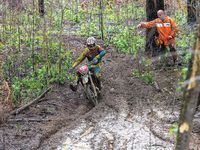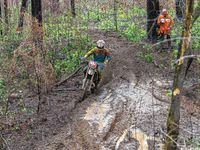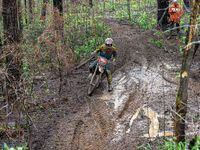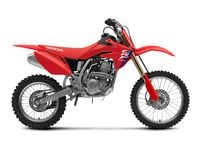This article was originally featured in the September 2017 print edition of Dirt Rider
Dirt Rider attended the wet and muddy Cajun Classic Enduro back in April where we watched the top riders in the country take a variety of lines through a particular nasty mud hole. Some went straight through it, with varied success, while others opted for the safer, but still gnarly, line around it.
We checked in with Nick Fahringer, who is one of the better “mudders” on the circuit, and asked him to explain why and how he chose to go around this particular hole.
According to Nick, the keys to successfully negotiating a nasty mud hazard are momentum, smart lines, smooth throttle application to avoid fishtailing or burying the rear in the soft stuff, and to always remember not to stick your toe into the unknown.
- "Here I round a slick corner and spot a mud hole just out of the exit. Thanks to a heads-up from this bald-headed fella in the orange jacket [Mike Lafferty], I quickly scan ahead for a good line through or around the mud.
“I’ve just exited a turn and I don’t have much speed or traction, so I need a smooth, high line to safely skim around this quicksand. If I had the drive and a little more run at it, a light front end and some momentum would power me through the main rut. But that’s not the case, so a smarter and safer line is in order.
- "I cut across to the side of the main rut to skate the edge of the deep stuff and gather momentum. I keep the outside peg weighted with my body square over the center of the bike while using a smooth application of the throttle to maintain traction so I can hold my line. Too much throttle will only dig the rear end in deeper.
- "If you must dab a foot, 'ski' your boot with toe up! Don't kick mud up into your goggles or catch your boot with a low pointing toe.
- "With both wheels tracking in the groove and my momentum picking up, I roll the throttle on steady to lighten the front end and drive out without sinking. Harder on the gas now, I align my body square over the bike with my eyes set on the next obstacle."




/cloudfront-us-east-1.images.arcpublishing.com/octane/SKYGGQY3XJCPDAM4CUHUXBS444.jpg)
/cloudfront-us-east-1.images.arcpublishing.com/octane/AONOEIBHJBGMBOCD5HBWVB3UAI.jpg)
/cloudfront-us-east-1.images.arcpublishing.com/octane/76O4I66VBNBS5GXX4DNHXXKHR4.jpg)
/cloudfront-us-east-1.images.arcpublishing.com/octane/3LSXOLSH3NEJDBMO3JZ6CYMK5M.jpg)

/cloudfront-us-east-1.images.arcpublishing.com/octane/QNIQ2A4UEBGNRKB4STEBJPMUX4.jpg)
/cloudfront-us-east-1.images.arcpublishing.com/octane/35SLCX4NQ5AFTHU6EY7FJSNGEY.jpg)
/cloudfront-us-east-1.images.arcpublishing.com/octane/LVH6MQASTRA2RJ74WY2PM7OAFI.jpg)
/cloudfront-us-east-1.images.arcpublishing.com/octane/TDBZ2JZJ7ZBNBLMB677WNPFLJE.jpg)
/cloudfront-us-east-1.images.arcpublishing.com/octane/3JLESTQC3RFDNBJBXT4OMYU65Q.jpg)
/cloudfront-us-east-1.images.arcpublishing.com/octane/4OOTARNHZRFEJJ5ZPVQMG3H6FE.jpg)
/cloudfront-us-east-1.images.arcpublishing.com/octane/MF32EN5WZNAEXCNYDYFNKMC2AE.jpg)
/cloudfront-us-east-1.images.arcpublishing.com/octane/UGLO3U37HJHGLM22F3D4XOWNVE.jpg)
/cloudfront-us-east-1.images.arcpublishing.com/octane/WSK35AT3LBBH7GZSXAXXREGF6U.jpg)
/cloudfront-us-east-1.images.arcpublishing.com/octane/OXEZZUYKDJHFVB4K7AIQSLRR7M.jpg)
/cloudfront-us-east-1.images.arcpublishing.com/octane/RVOG445TMRAZBNJ77OV3TN5QGQ.jpg)
/cloudfront-us-east-1.images.arcpublishing.com/octane/IQNDTQPP4BE3HE5JUWJ36ONAUU.jpg)
/cloudfront-us-east-1.images.arcpublishing.com/octane/Z6YUC3S26FF4TOKFTXZ7I746YY.jpg)
/cloudfront-us-east-1.images.arcpublishing.com/octane/UOWIK3H4BJHP7F4ONETCB7IXDQ.jpg)
/cloudfront-us-east-1.images.arcpublishing.com/octane/6KKT5NNL2JAVBOXMZYS5ZO76YA.jpg)
/cloudfront-us-east-1.images.arcpublishing.com/octane/PCDJQEHF35A4LCOEW2WGBIAD64.jpg)
/cloudfront-us-east-1.images.arcpublishing.com/octane/YKESTHMNBRBP7PWRYKIMEUU3MQ.jpg)
/cloudfront-us-east-1.images.arcpublishing.com/octane/GMXQJSFPSJFNHE44YQIMDRBUQE.jpg)
/cloudfront-us-east-1.images.arcpublishing.com/octane/XF37XUN7OBBHXAZ6OWLXUNDWAI.JPG)